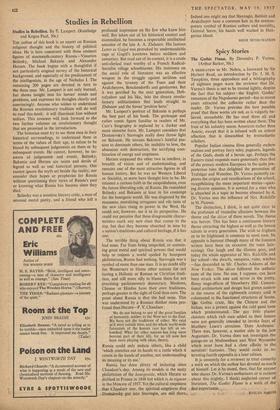Spicy Stories
The Gothic Flame. By Devendra P. Varma. (Arthur Barker, 30s.) A DEDICATION to Mr. Nehru, a foreword by Sir Herbert Read, an introduction by Dr. J. M. S. Tompkins, three appendices and a bibliography
of eighteen pages warn the reviewer that Dr.
Varma's thesis is not to be treated lightly, despite the fact that his subject—the English `Gothic' romances of the Napoleonic period—has in recent years attracted the collector rather than the reader. Dr. Varma provides the best possible proof that these works are not, as is vulgarly be- lieved, unreadable. He has read them all and everything that has been written about them. The fruit of his industry seems American rather than Asiatic, except that it is infused with an ardent affection that is dissembled by transatlantic scholars.
Popular Indian cinema films generally eschew realism and portray fairy tales, pageants, legends of the Gods, deeds of a heroic age. Perhaps the Eastern mind responds more generously than that of the prosaic modern European to the quite pre-
posterous tales that delighted the generation of
Trafalgar and Waterloo. Dr. Varma patiently ex- plores the origins and ramifications of the school, recapitulating the more important stories—quot- ing diverse opinions. It is normal for a man who is absorbed in a topic to become obsessed by it. Dr. Varma sees the influence of Mrs. Radcliffe in M. Picasso.
The distinction, I think, is not quite clear in
the profusion of recondite allusions between the theme and the decor of these novels. The theme
was horror. This has been a continuous literary theme attracting the highest as well as the lowest talents in every generation. The wish to frighten or to be frightened is common to most men. Its opposite is humour (though many of the funniest writers have been on occasion the most hair- raising). One laugh and the illusion goes, and today the whole apparatus of Mrs. Radcliffe and her, school—the dwarfs, vampires, ruins, witches —has descended to Mr. Charles Addams of the
New Yorker. The decor followed the xsthetic ,taste of the time. No one, I suppose,. can have been struck with awe and terror, in the pretty,
flimsy stage-effects of Strawberry Hill. Conven- tional architecture and design had grown austere in the course of the eighteenth century until it culminated in the functional structures of Soane.
Tolie Gothic craze, like the Chinese and the Indians was a protest against the cold good taste which predominated..; The gay little plaster cloisters which rich men added to their houses were not generally intended to invoke fears of Matthew Lewis's atrocious 'Dom Ambrosio.' There was however, a nastier side to the late Augustans. Dr. Varma does not investigate the goings-on at Medmenham and West Wycombe which must have had a close affinity to the novelists' fantasies. They would make an in- teresting fourth appendix in a later edition.
It is unseemly, for a reviewer to treat cursorily a work on which the author has devoted so much of himself. Let it be stated, then, that for anyone who shares Dr..Varma's.enthusiasm or is curious about this !(rightly, 1 think),neglected corner of literature, The Gothic Flame is a work of the .;;Air Stimportanee, ,
EVELYN W441G1.11


































 Previous page
Previous page